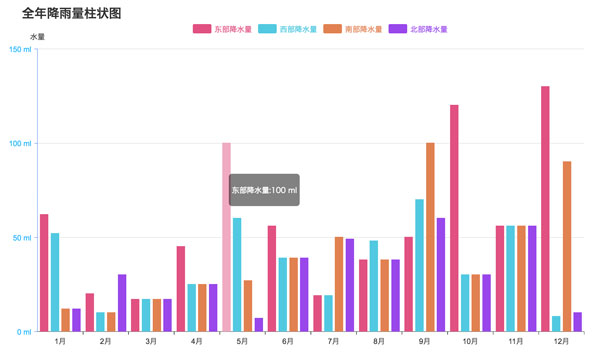通过HTML5规范搞定i、em、b、strong元素的区别
时间:2017-04-08前言
为了语义化HTML5增加了不少新标签。其中i、em和b、strong这两组标签是最容易弄混的,不好好去探究一下,还真说不清。这个也是前端面试中经常会问的问题。今天从源头上,也就是从HTML5的文档(https://w3c.github.io/html/textlevel-semantics.html#the-em-element)中来一探究竟!
区别详解
首先,单从显示效果来看,在不额外添加css的情况下,i和em标签包围的文字将会以斜体呈现,b和strong标签包围的文字则会加粗显示。如图

效果如下:

<b>和<i>在创建之初就是简单地表示粗体和斜体样式,但是到了HTML5,为了语义化特性,这两个标签也被赋予了语义,样式倒不那么重要,因为那是css的事情。但上面两组标签语义还是各有侧重,下面依照规范逐一介绍:
i介绍
规范描述:
The i element represents a span of text in an alternate voice or mood, or otherwise offset from the normal prose in a manner indicating a different quality of text, such as a taxonomic designation, a technical term, an idiomatic phrase from another language, transliteration, a thought, or a ship name in Western texts.
译文:
i 元素代表在普通文本中具有不同语态或语气的一段文本,某种程度上表明一段不同特性的文本,比如一个分类学名称,一个技术术语,一个外语习语,一个音译,一个想法,或者西方文本中的一艘船名。
举例:
// 分类学名称 <p>The <i class="taxonomy">Felis silvestris catus</i> is cute.</p> // 术语 <p>The term <i>prose content</i> is defined above.</p> // 外语习语 <p>There is a certain <i lang="fr">je ne sais quoi</i> in the air.</p>
大家可以在i标签上应用class来表明用这个元素的意图,这样该特殊样式在以后如需修改时,不需要仔细检查全部文档来更改。在使用i标签时候时,推荐考虑是否应用其他标签更为合适,如用em来突出强调,dfn标签来定义项目实例。
em介绍
规范描述:
The em element represents stress emphasis of its contents.
The placement of stress emphasis changes the meaning of the sentence. The element thus forms an integral part of the content. The precise way in which stress is used in this way depends on the language.
译文:
em 元素代表对其内容的强调。突出强调的位置会改变语句本身的意义。因此,元素构成内容的一个部分。用这种方式表示强调的程度依赖于是何种语言。
举例(类似汉语里面重读某个词表示不同含义):
// 这是一句不带任何强调的句子 <p>Cats are cute animals.</p> // em 包围 Cats,强调猫是种可爱的动物,而不是狗或者其他动物 <p><em>Cats</em> are cute animals.</p> // em 包围 are,代表句子所说是事实,来反驳那些说猫不可爱的人 <p>Cats <em>are</em> cute animals.</p> // em 包围 cute,强调猫是一种可爱的动物,而不是有人说的刻薄、讨厌的动物 <p>Cats are <em>cute</em> animals.</p> // 这里强调猫是动物,而不是植物 <p>Cats are cute <em>animals</em>.</p>
规范末尾note:
The em element isn’t a generic "italics" element. Sometimes, text is intended to stand out from the rest of the paragraph, as if it was in a different mood or voice. For this, the i element is more appropriate.
The em element also isn’t intended to convey importance; for that purpose, the strong element is more appropriate.
译文:
em不是一个普通的斜体标签。有时为了部分文本由于不同的语态或语气需有别于段落的其他部分,这是i标签更为合适。em标签不是为了表明重要性,如果是出于这个目的,strong标签更为合适。
b介绍
规范描述:
The b element represents a span of text to which attention is being drawn for utilitarian purposes without conveying any extra importance and with no implication of an alternate voice or mood, such as key words in a document abstract, product names in a review, actionable words in interactive text-driven software, or an article lede.
译文:
 历时三年 W3C宣布HTML5规范正式定稿历时三年 W3C宣布HTML5规范正式定稿HTML5中文学习网,是中国最大的HTML5中文门户,为广大HTML5爱好者提供各种HTML5资料,
历时三年 W3C宣布HTML5规范正式定稿历时三年 W3C宣布HTML5规范正式定稿HTML5中文学习网,是中国最大的HTML5中文门户,为广大HTML5爱好者提供各种HTML5资料, 有关HTML5页面在iPhoneX适配问题这篇文章主要介绍了有关HTML5页面在iPhoneX适配问题,需要的朋友可以参考下
有关HTML5页面在iPhoneX适配问题这篇文章主要介绍了有关HTML5页面在iPhoneX适配问题,需要的朋友可以参考下 html5中canvas图表实现柱状图的示例本篇文章主要介绍了html5中canvas图表实现柱状图的示例,本文使用canvas来实现一个图表,小编觉得挺不错的,现在分享给大家
html5中canvas图表实现柱状图的示例本篇文章主要介绍了html5中canvas图表实现柱状图的示例,本文使用canvas来实现一个图表,小编觉得挺不错的,现在分享给大家